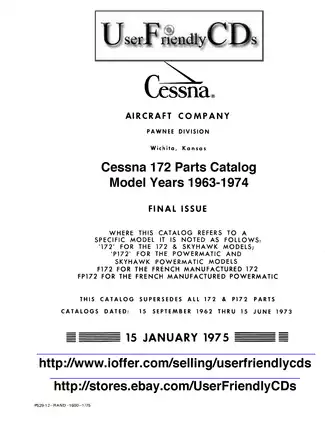Cessna 172 & Skyhawk models: P172, F172, FP172 - Official Parts Catalog & Illustrated Reference (1963-1974)
Product Gallery

Sample pages from the Cessna 172 & Skyhawk models: P172, F172, FP172 - Official Parts Catalog & Illustrated Reference (1963-1974) manual

Purchase Information
1963-1974 Cessna 172 & Skyhawk Parts Catalog - Technical Specifications
- Document Number / Seller:
- 24860 / Peter Lewis
- File Size:
- 17.36 MB
- File Type:
- Language:
- English
- Pages:
- 670
- Printable:
- Yes
- Estimated Download Time:
- 0.36 Minutes
- Delivery Format:
- Digital (PDF) - Instant Access
- Category:
- Aircraft
- Brand:
- Cessna
- Reviewed and Approved:
- Jul 4, 2025
Cessna Models and Parts Covered in this Aircraft Manual
- Cessna 172 (1963-1974)
- Cessna 172 Skyhawk (1964-1974)
- Cessna P172 (1963-1974)
- Cessna F172 (1963-1974)
- Cessna FP172 (1963-1974)
Complete Manual Information
Cessna 172 Parts Catalog (1963-1974)
This Cessna 172 Parts Catalog is an extensive illustrated manual detailing the parts and components of the Cessna 172 aircraft models produced from 1963 to 1974. Whether you're a mechanic, aircraft owner, or aviation enthusiast, this digital manual serves as an invaluable resource for identifying parts easily and quickly. The catalog features a user-friendly layout with a comprehensive index, ensuring you access the relevant information without hassle.
Why Choose This Manual?
- Illustrated Parts Identification: Each part is accompanied by clear, detailed illustrations, allowing for easy identification.
- Comprehensive Information: This guide includes parts lists, effective dates, and specifications to ensure you have all the information at your fingertips.
- Revision Updates: The latest changes and revisions are documented to keep your manual current and applicable.
What's Inside
The catalog contains sections detailing:
- Index of Parts: An alphabetical and numerical index to navigate easily.
- Effective Pages List: Documenting all changes, allowing for reference to the latest updates.
- Assembly and Component Lists: Includes listings for accessories, flight instruments, and structural components.
- Maintenance Tips: Considerations for parts installation and replacement are detailed throughout for better upkeep.
Table of Contents:
- Introduction
- Illustrated Parts Catalog
- Engine Components
- Control Systems
- Airframe Components
- Electrical Systems
- Fuel Systems
- Safety Equipment
- Effective Pages List
- Index
This digital manual is an essential companion for anyone who works with or owns a Cessna 172, ensuring that maintenance and repairs are performed with accuracy and confidence
Download Instructions for Cessna Aircraft Manual
Frequently Asked Questions - Cessna Aircraft Manual
What does this Cessna manual cover?
This comprehensive service manual covers detailed repair procedures, maintenance schedules, troubleshooting guides, and technical specifications for Cessna 172 & Skyhawk models: P172, F172, FP172 - Official Parts Catalog & Illustrated Reference (1963-1974). It includes information for the following models: - Cessna 172 (1963-1974) - Cessna 172 Skyhawk (1964-1974) - Cessna P172 (1963-1974) - Cessna F172 (1963-1974) - Cessna FP172 (1963-1974).
Is this manual suitable for beginners?
Yes, this Cessna manual is designed for both professional technicians and DIY enthusiasts. It includes step-by-step procedures with clear illustrations and safety guidelines for Aircraft maintenance and repair.
What file format will I receive?
You will receive this manual as a PDF file (17.36 MB), which is compatible with all devices. The manual is fully searchable and printable for your convenience.
How quickly can I access the manual after purchase?
You'll receive instant access to your Cessna Aircraft manual immediately after payment completion. The download link is valid for 3 days, with lifetime re-download guarantee.
Can I print specific sections of the manual?
Absolutely! This digital manual allows you to print any section you need, from individual pages to complete chapters, making it perfect for workshop use.
Customer Reviews and Feedback
Read what our customers say about this Cessna Aircraft manual and share your own experience.
Add Comment
This policy contains information about your privacy. By posting, you are declaring that you understand this policy:
- Your name, rating, website address, town, country, state and comment will be publicly displayed if entered.
- Aside from the data entered into these form fields, other stored data about your comment will include:
- Your IP address (not displayed)
- The time/date of your submission (displayed)
- Your email address will not be shared. It is collected for only two reasons:
- Administrative purposes, should a need to contact you arise.
- To inform you of new comments, should you subscribe to receive notifications.
- A cookie may be set on your computer. This is used to remember your inputs. It will expire by itself.
This policy is subject to change at any time and without notice.
These terms and conditions contain rules about posting comments. By submitting a comment, you are declaring that you agree with these rules:
- Although the administrator will attempt to moderate comments, it is impossible for every comment to have been moderated at any given time.
- You acknowledge that all comments express the views and opinions of the original author and not those of the administrator.
- You agree not to post any material which is knowingly false, obscene, hateful, threatening, harassing or invasive of a person's privacy.
- The administrator has the right to edit, move or remove any comment for any reason and without notice.
Failure to comply with these rules may result in being banned from submitting further comments.
These terms and conditions are subject to change at any time and without notice.
Comments (5)